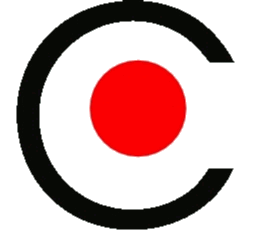

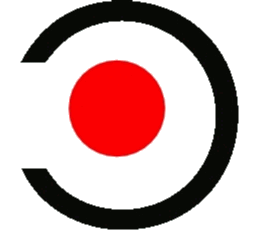

|

|

|
|
2007/05, May Photofictional, A Daily Blog Posting By Bryan Costales
|
|
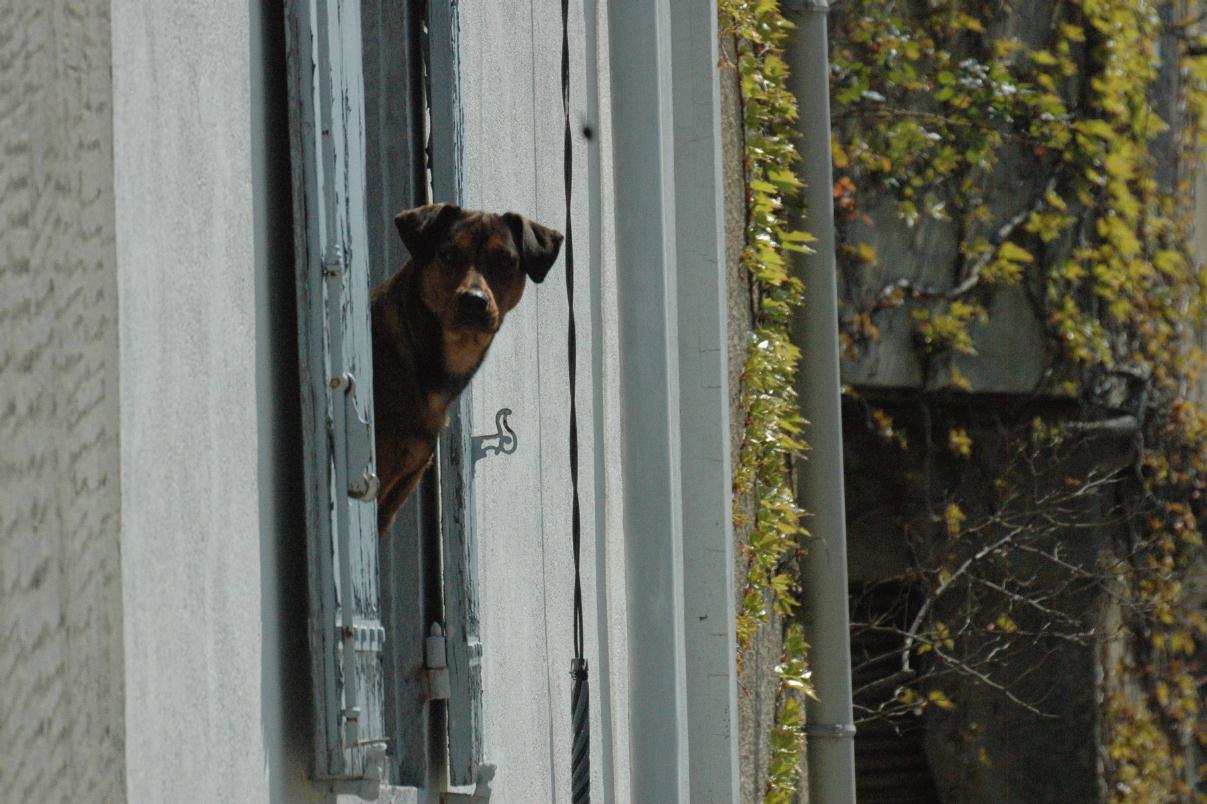 | |
|
Dog observes photographer
I was walking back to the boat and looked down a side street. In the photo you might think it's a doorway but it is actually a window several feet above the street. I saw this large dog looking out and originally it was looking the other way. I focused on him, got the picture framed then made that universal kissy noise that all, including the French, make to call their dogs. It worked. He whipped his head around and I got that great curious look. Photo posted Tuesday, May 1, 2007 • © 2007 Terry Costales 
 #BP20070501.jpg Add a comment or report a mistake
|
|
|
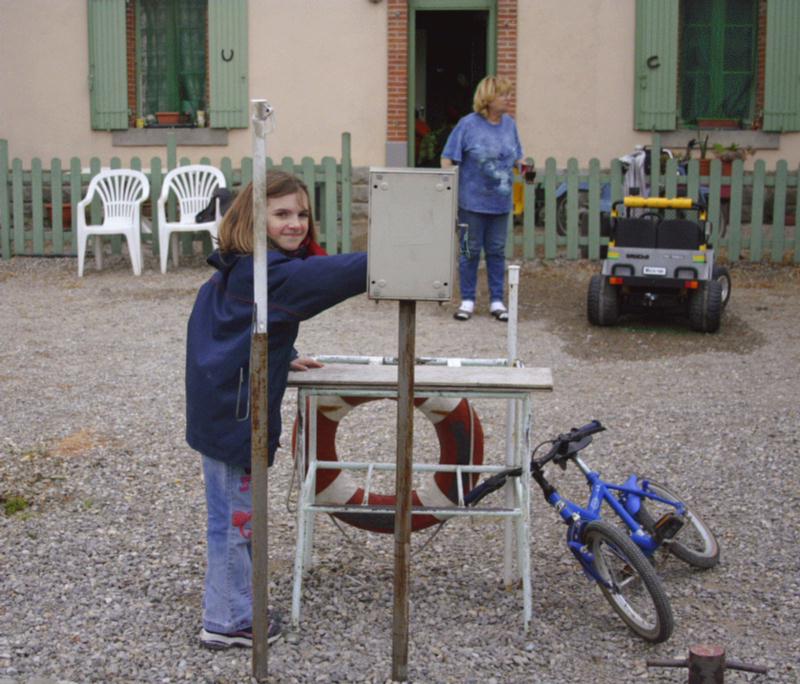 | |
|
Bryan Costales Wednesday 2 May 2007 This reminds me of the upstream battle with locks. Normally, lock keepers are among the most helpful people in France. They will catch your ropes when tossed and help you cleat your boats. This is most appreciated, especially when traveling light handed in a canal boat. But for some reason, over Easter week, the lock keepers on the Canal du Midi, to a man, refused to touch a rope. The one exception was the young girl pictured here by Dr. Carter. She took our lines, cleated them, and ran the boat through the lock. She also closed the place up at the end of the day. Her Grandpa was very impressed by the 2 euro tip she received. Bravo! (2007) Canal du Midi, east of Argens, France, E.U. • Photo posted Wednesday, May 2, 2007 • © 2007 Dr. William Carter 
 #BP20070502.jpg Add a comment or report a mistake
|
|
|
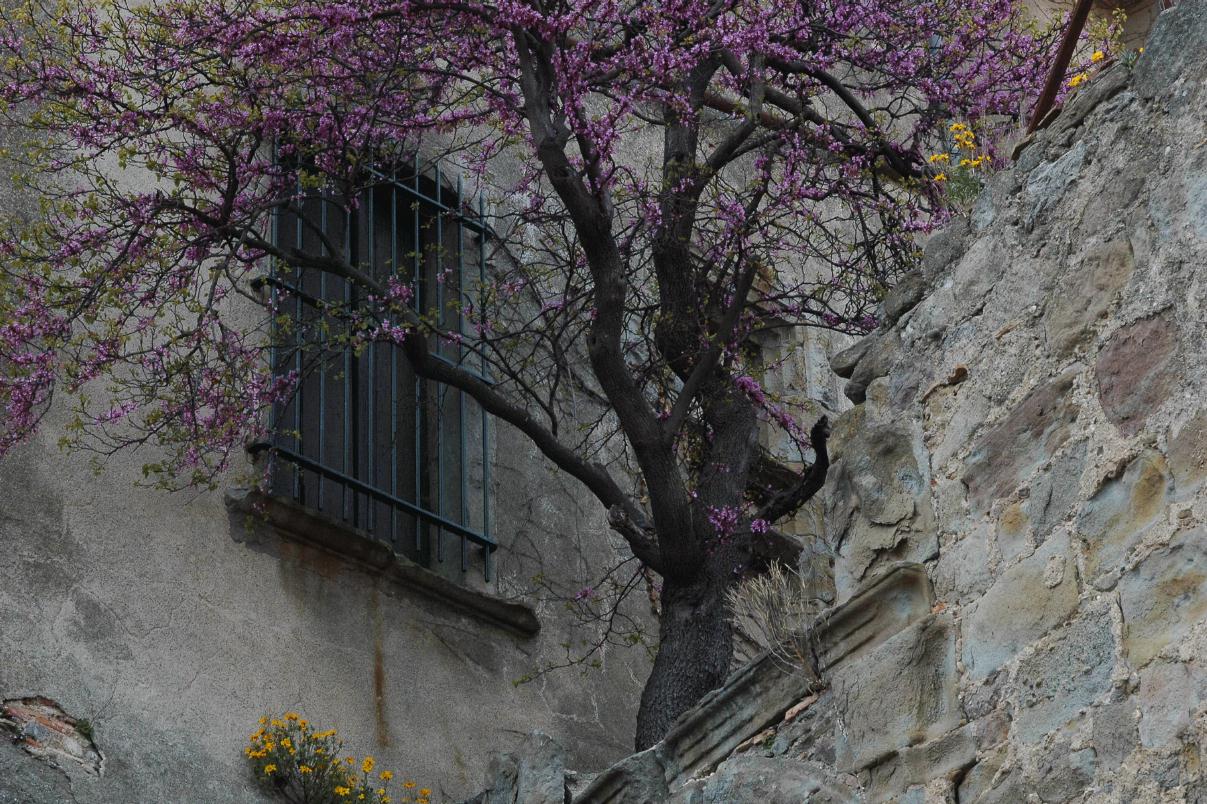 | |
|
Nothing can compare to good lighting to separate one component
from another
in a photograph.
One sometime, however, moves out of the light and into the shadows.
Here, for example, a tall church blocked all the sunlight
from this side of the building.
Normally such an image would hit the trash because of its lack of separation. But here, the colors serve the same purpose that light would have normally served. The purple flower canopy accented by yellow splashes soften the cold stone and allow the dark wood of the tree to move forward. An accidental photo that turned out well. (2007)Puicheric, on Canal du Midi, France, E.U. • Photo posted Thursday, May 3, 2007 • © 2007 Bryan Costales 
 #BP20070503.jpg Add a comment or report a mistake
|
|
|
 | |
|
While driving north on a French freeway, somewhere near the eastern outskirts of Paris,
I noticed a fire. Struck by the bright blue sky, dark smoke, greenery, and the red and white
fire ladder that so nicely framed everything, I grabbed my handy camera and shot this photo.
Bryan Costale Friday 4 May 2007 This serves as a lesson why you should always keep your camera at the ready. You never know when you might drive up on a great shot. Ducks waddling along the center of a freeway, a tanker truck flipped on an overpass, or a great smile from the car next to yours. Try to never find that great shot when your camera uselessly left at home. (2007) Somewhere outside Paris, France, E.U. • Photo posted Friday, May 4, 2007 • © 2007 Dr. William Carter 
 #BP20070504.jpg Add a comment or report a mistake
|
|
|
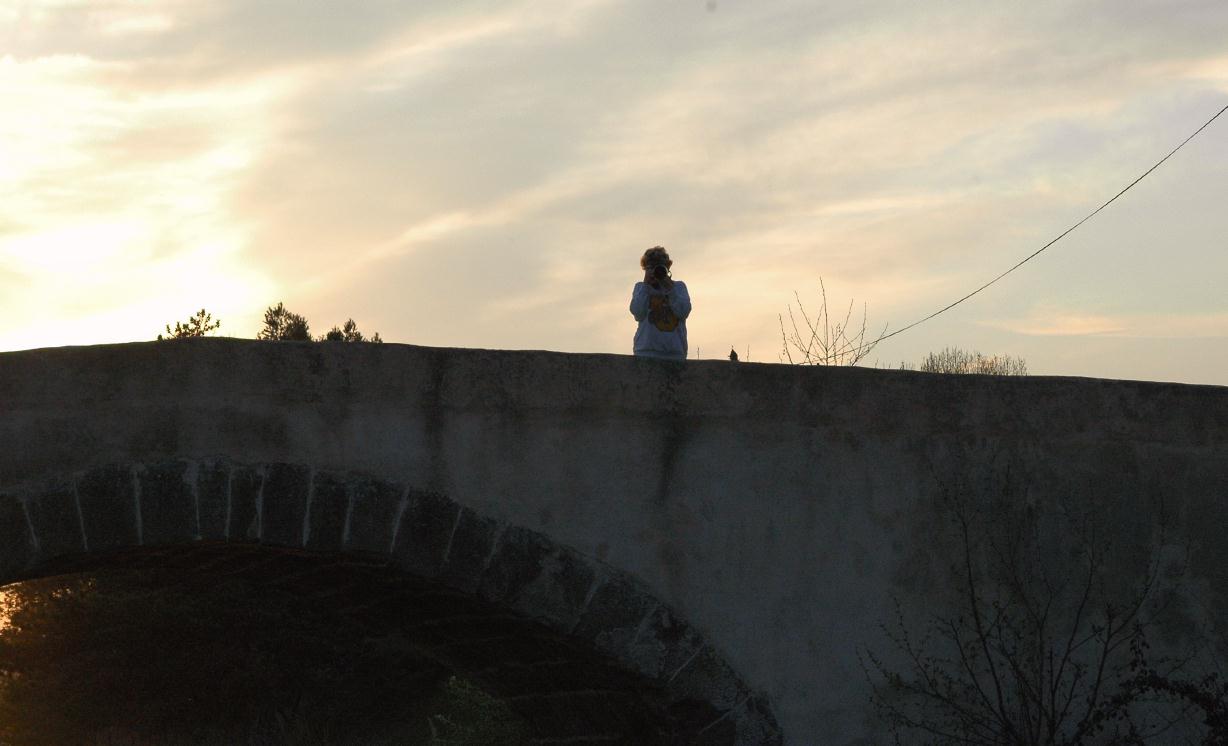 | |
|
In the old days of film and optical printing there were few ways
to fix a marred photograph.
Burning, dodging
One photographer I know would not display this image without first
spending 10 minutes erasing the telephone wire
We at bcx.news stand for honest photography. Allan Woods, Sunday 6 May 2007 So, if I take a digital color image and REMOVE the color information, am I creating a "more truthful" lie? Modification of the image is what photography is. You cannot draw a clear line between what is "alteration" and what is not. Once you begin to object to making a picture more esthetically pleasing by removing distracting wires (which are neither the subject of the image nor prominent enough to make some point) you start down a path which has no end, nor any point.
Dr. William Carter, Monday 7 May 2007 Re: "With the wire, the viewer experiences a different metaphor than the viewer would experience without the wire. We at bcx.news stand for honest photography" All photography is an abstraction; both of time and space. One's choice of format, lens focal length, plane of focus, depth of field, overall exposure, duration of exposure, color saturation; the use of swings, tilts, rises, and falls; 3-D vs. 2-D, method of 3-D; medium of display: The sum of these and other elements contribute to a final representation of some highly editorialized viewfinder selection of a, mute, cold, simplistic splinter of reality. Insensate and contextually deprived. As Goddard might have you believe, film is not "truth, 24 times a second". That's a nice sound-bite, but it's a lie. Is B&W inherently less honest than color? Is 2-D inherently less honest than 3-D?
Is my photo of "a window across the street"
(Windows2006_08.jpg Is removing non-essential distractions from a shot; say, something like, oh, I don't know, powerlines from behind a photo of Terry, being dishonest? I think that would be more honest, certainly more honest to the craft. Were Titian's reds "honest"? Rembrandt's lighting "honest"? When Michelangelo carved the statue "David", he did so in a disproportionate way so that it would appear proportional when viewed from below. Was he being dishonest? Were Cezanne, VanGogh, Degas, Monet all dishonest? Photography is a vehicle of communication. "Reality" is not it's domain. Given the tools we have today, I think it's poor photography not to consider using them. Or just laziness. Or an absurdly obdurate and obtrusive notion that a photograph is, somehow, "real." (2007) Canal du Midi, west of Argens, France, E.U. • Photo posted Saturday, May 5, 2007 • © 2007 Bryan Costales 
 #BP20070505.jpg Add a comment or report a mistake
|
|
|
 | |
|
No question that the French can cut the mustard.
Bryan Costales, Sunday 6 May 2007
In fact many fine mustards come from France where
perhaps the best known is Dijon
In America,
there too are mustard fields. In America the most infamous of the
American mustards is French's, a pale yellow mustard. French's Mustard
(2007) On the road toward Paris • Photo posted Sunday, May 6, 2007 • © 2007 Dr. William Carter 
 #BP20070506.jpg Add a comment or report a mistake
|
|
|
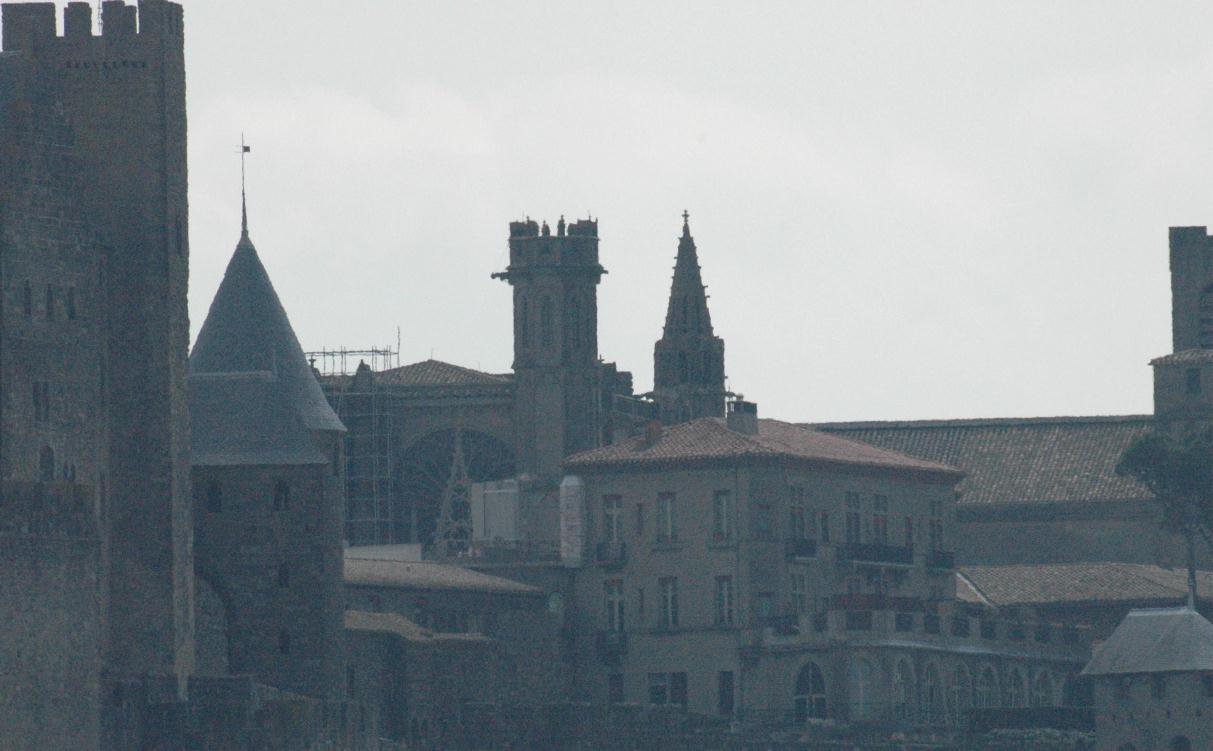 | |
|
The walled castle at Carcassonne, called the
Cité
Fortunately, I had a 500mm lens that allowed me to grab a picture of
it from the top of a bridge
(2007) Carcassonne, France, E.U. • Photo posted Monday, May 7, 2007 • © 2007 Terry Costales 
 #BP20070507.jpg Add a comment or report a mistake
|
|
|
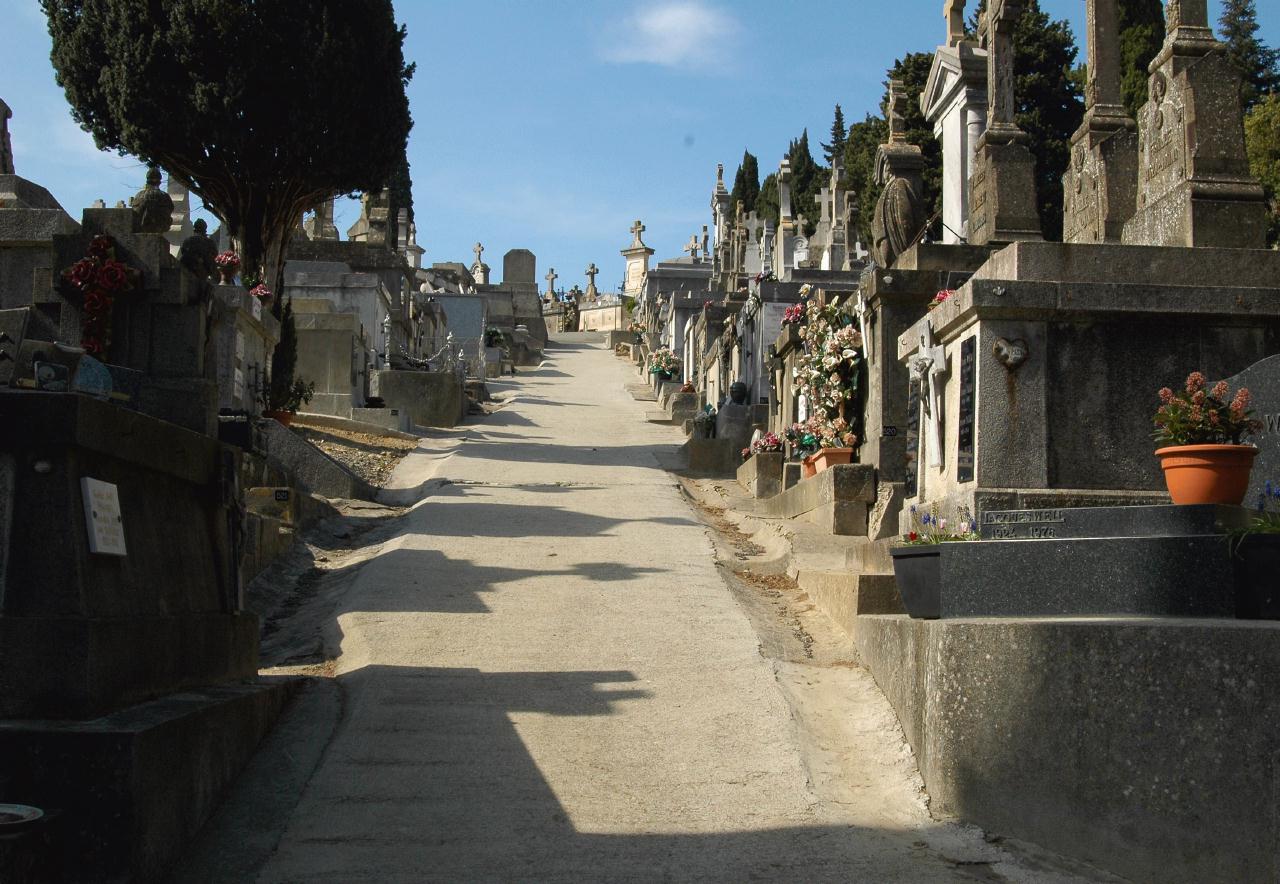 | |
|
In France, the black plague
During the 1300's, Europe lost half of its total population. Is it any wonder that the graveyards of Europe are so full? (2007) Cemetery at Carcassonne, France, E.U. • Photo posted Tuesday, May 8, 2007 • © 2007 Bryan Costales 
 #BP20070508.jpg Add a comment or report a mistake
|
|
|
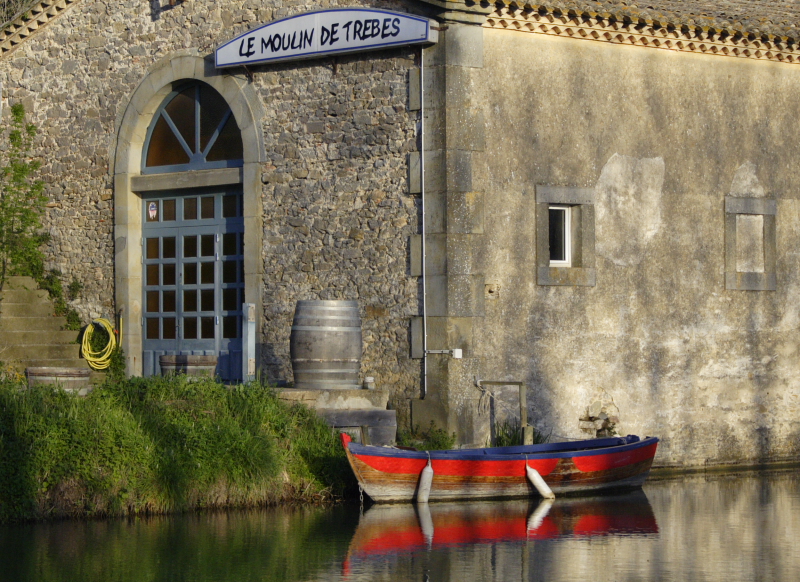 | |
|
An overnight stop in Trebes.
Bryan Costales, Wednesday 9 May 2007 Three of us sat on the back of the boat as the sun quietly set. The wind died leaving the water glass still. We shot this same boat at different times using different lenses on different cameras. Some of these shots were good and will appear elsewhere, later on this site. Some were flawed and discarded. This shot was selected because it illustrates an important lesson.
Whenever you find the perfect subject in imperfect light, try to
wait patiently for the
light to mature (2007) Trebes on Canal du Midi, France, E.U. • Photo posted Wednesday, May 9, 2007 • © 2007 Dr. William Carter 
 #BP20070509.jpg Add a comment or report a mistake
|
|
|
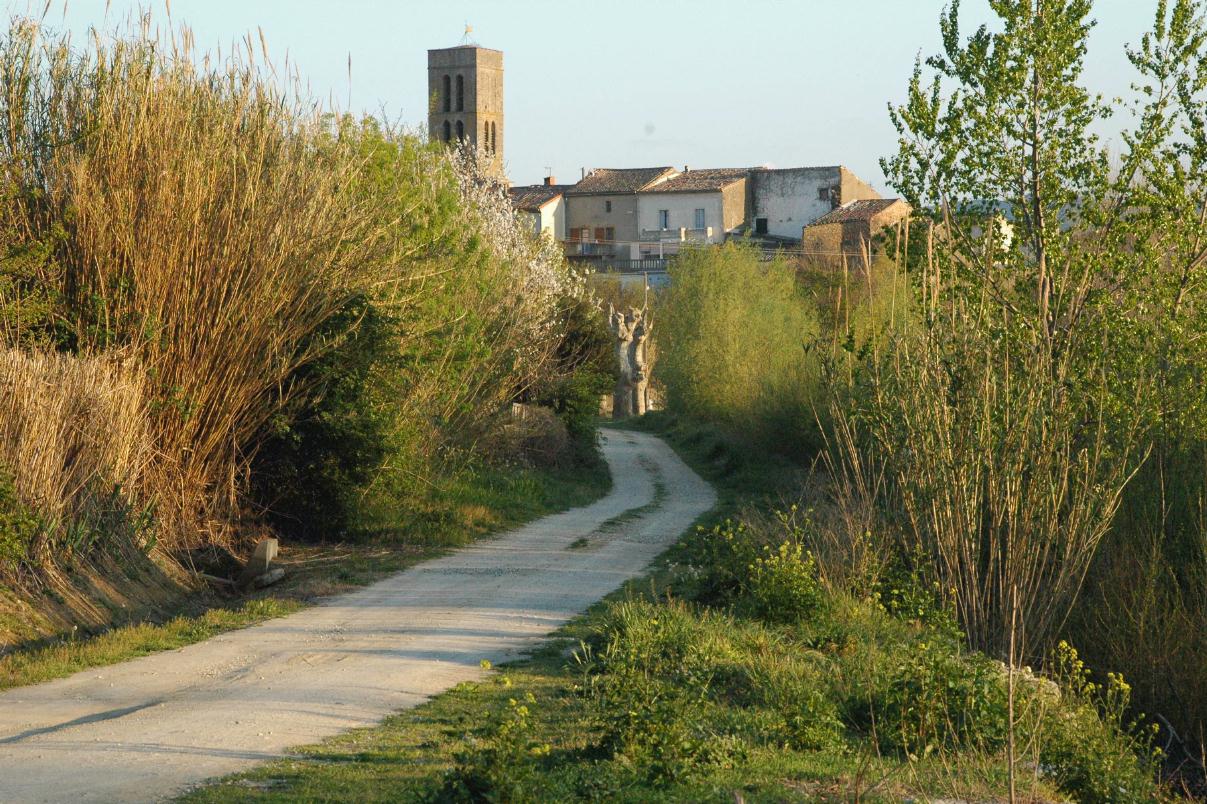 | |
|
When we got to Trebes, we decided to not tie up in the main
marina because of some noisy Spaniards. Instead we motored to the
edge of town where we found this dirt road. Although the road
appears to run into town, it actually (like so many roads in
Europe) does not go where it appears to.
Instead, following his road takes one to a set of private vegetable gardens on the town's outskirts. Past the gardens is a major road perpendicular to this that actually runs into town. Despite the narrowness of this dirt road, one car did speed out it at a good clip. So beware all cars, no matter how dinky the road or how placid the scene. (2007) Trebes on Canal du Midi, France, E.U. • Photo posted Thursday, May 10, 2007 • © 2007 Bryan Costales 
 #BP20070510.jpg Add a comment or report a mistake
|
|
|
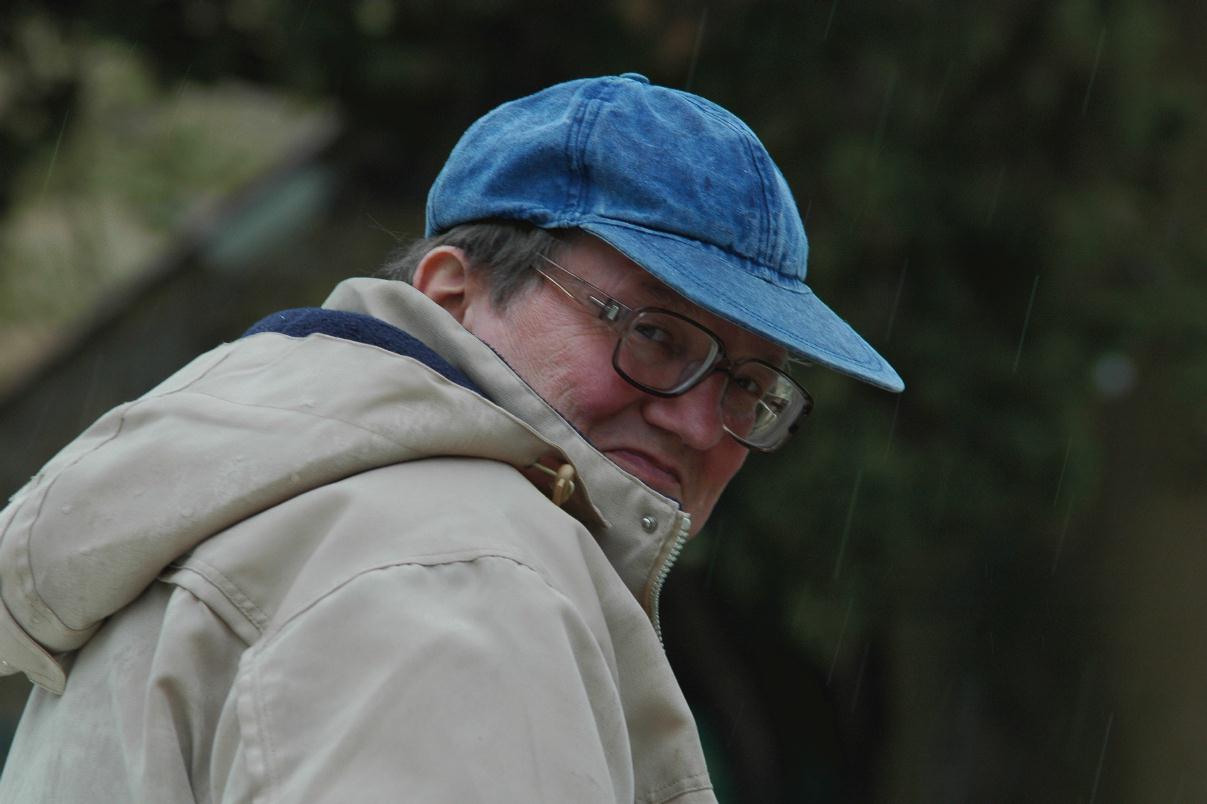 | |
|
While docked in Le Somail, we worried as the weather
clouded and began to rain. We cut our photo outing short
to escape, and from the safety of the boat shot ducks and
folks also escaping
From the next boat ahead a British gentleman and his wife emerged to untie and cast off. We had a friendly chat with them about the canals in England, which are narrower. His scowl in this shot is not actually from the rain, but from having his picture taken. (2007) Le Somail, France, E.U. • Photo posted Friday, May 11, 2007 • © 2007 Bryan Costales 
 #BP20070511.jpg Add a comment or report a mistake
|
|
|
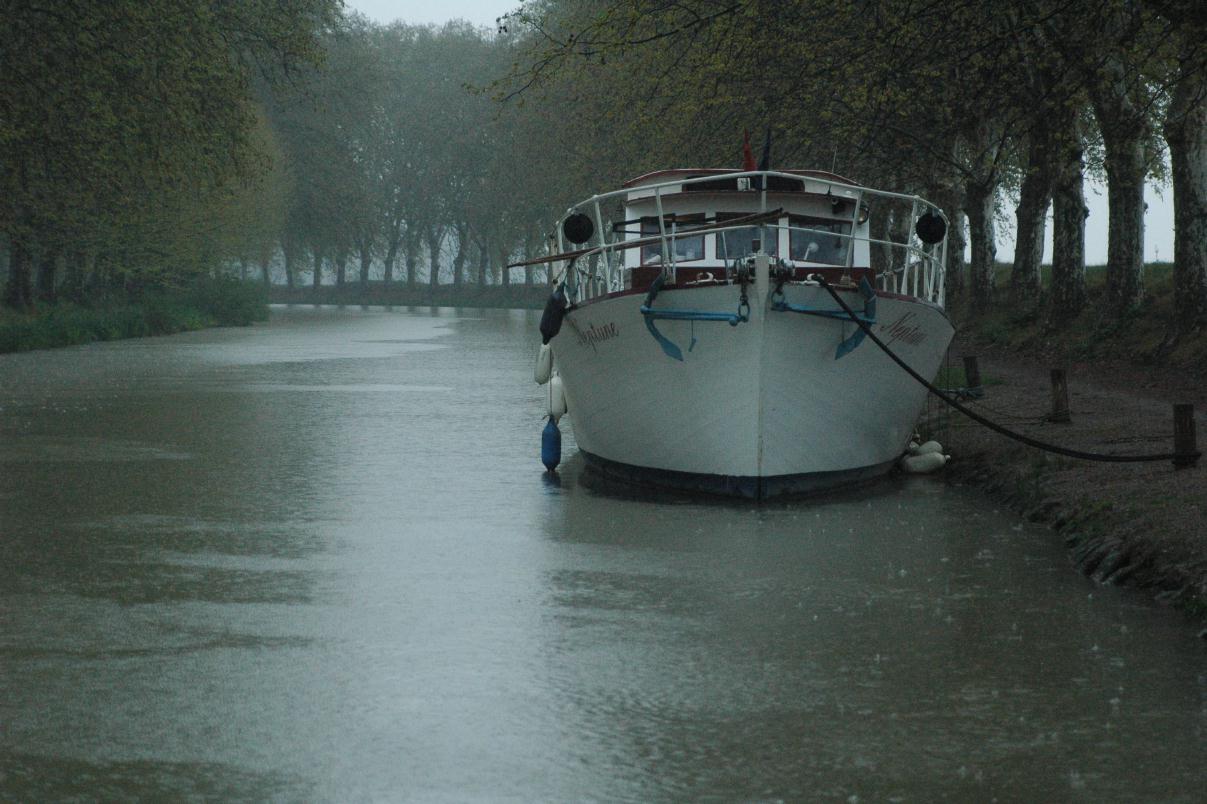 | |
|
Heavy rain is difficult to capture in the country without
some sort of backlight to make it stand out. In the city,
rain is easy because street and building lights help isolate
rain from the background.
Unusual puddles
The dappling of rain on the water, the glisten of the boat, the fading of the trees, and the slight tilt leeward of the boat all say "rain" perfectly. (2007) Canal du Midi west of Argens, France, E.U. • Photo posted Saturday, May 12, 2007 • © 2007 Bryan Costales 
 #BP20070512.jpg Add a comment or report a mistake
|
|
|
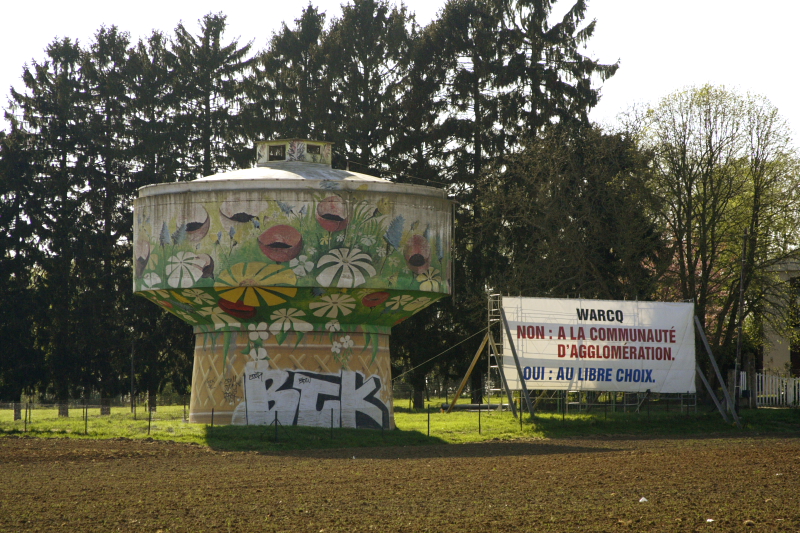 | |
|
Pesky French
Flower to the People! Bryan Costales, Sunday 13 May 2007 I am sure there is more of a story here than Dr. Carter admits. The sign says that individual liberty is preferred over gathering the community into one. Why is this sign next to a decorated container building? Where was this photo taken? Other than the two objects creating a natural joke, why should we care? Photo posted Sunday, May 13, 2007 • © 2007 Dr. William Carter 
 #BP20070513.jpg Add a comment or report a mistake
|
|
|
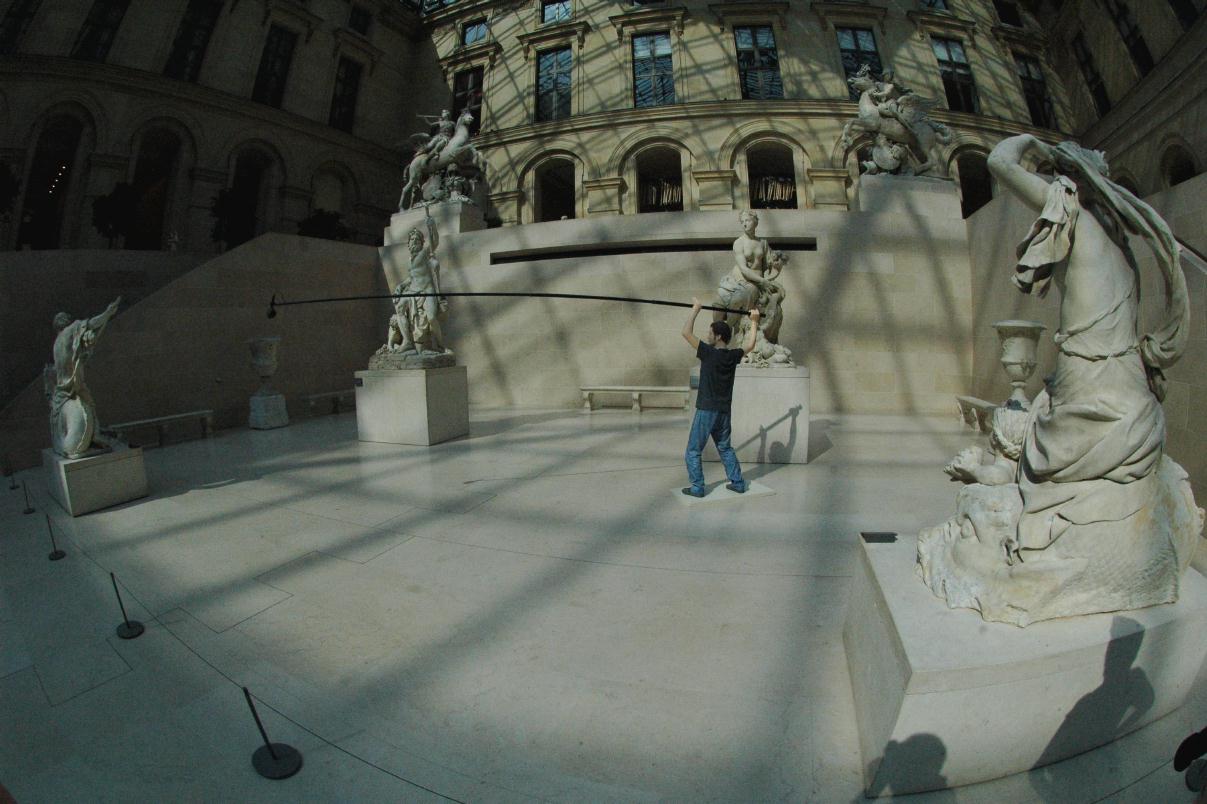 | |
|
Statue of a man with a boom mike
While wandering through one of the former outdoor statuary gardens (now covered with a glass roof) we noticed what appeared to be a film being shot inside the museum. We became quiet and walked softly up to watch. With an internal bolt of surprise we realized the boom operator was actually a statue. We'd been fooled.
When old sculpture is mixed with new Photo posted Monday, May 14, 2007 • © 2007 Bryan Costales 
 #BP20070514.jpg Add a comment or report a mistake
|
|
|
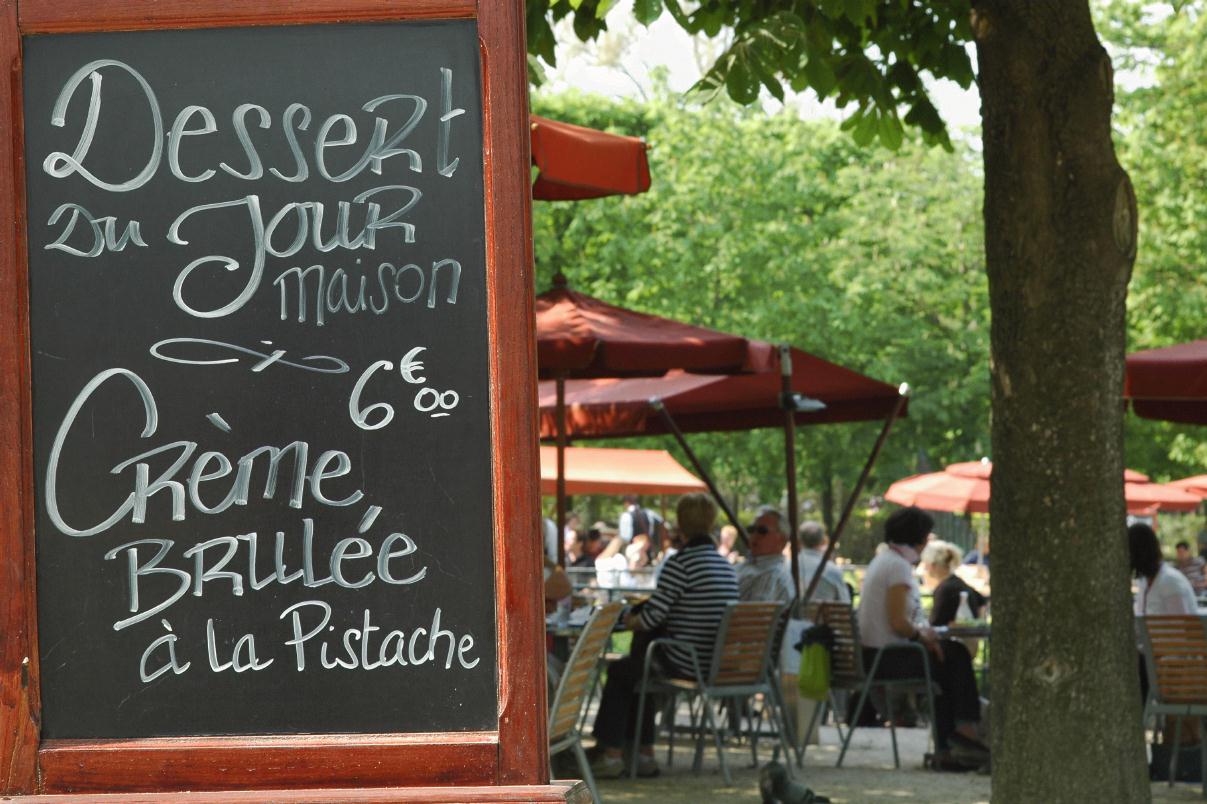 | |
|
Menu at restaurant under leafy chestnut trees
This is the sign for the Cafe Dame Tartine,
a restaurant that has a reputation for being expensive.
Notice the dessert, a créme brulée with pistachio.
The exchange rate at the time equated €6 to about
U.S. $12. Clearly, the expense of this cafe encouraged the establishment of many
fast-food stands
Unlike most of Paris, this garden offered a sprinkling of food places all within an easy walk of the others. But venture outside the garden to the streets and the story changes. In Paris, on the right bank, restaurants cluster on busy corners. One can walk two or more long blocks before finding a cluster of restaurants. When hungry, this spacing lends the impression of a desert of restaurants. Imagine that. Stuck in Paris and not a restaurant to be found. In France, the work week is 35 hours. As a consequence, restaurants are only open for lunch until 2:00 p.m., then close and don't open again until 7:00 p.m. for dinner. If, as many Americans do, you get hungry at 4:00 or 5:00 p.m. you are out of luck. The only alternatives are the small markets, gas stations (for sandwiches), or fast food outlets like McDonalds. Fortunately, near the train stations, one can often find ethnic food open at all times. (2007) Jardin Des Tuileries, Paris, France, E.U. • Photo posted Tuesday, May 15, 2007 • © 2007 Bryan Costales 
 #BP20070515.jpg Add a comment or report a mistake
|
|
|
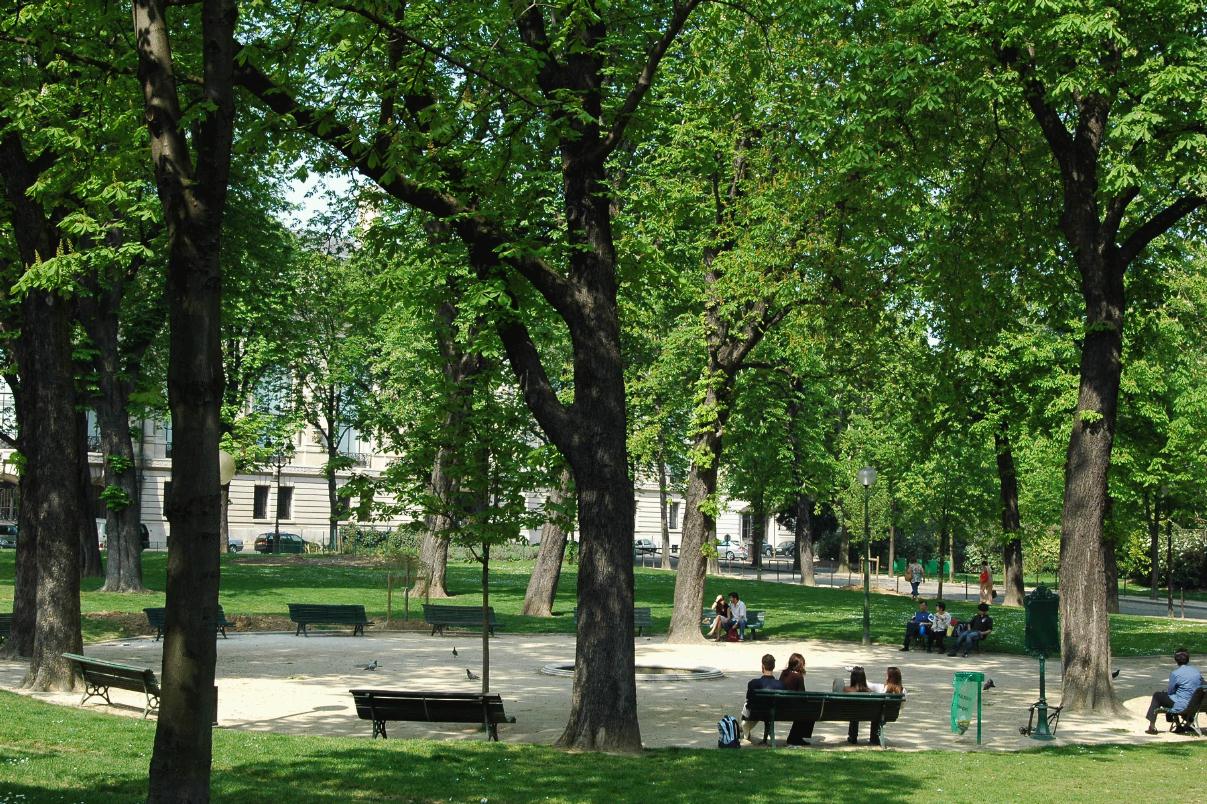 | |
|
Small parks surround the vast gardens along the right
bank of the Siene. Some, such as the one shown here, are
visible to, and frequented by, tourists. Others are more
hidden, such as another small park we later found that snaked
along the path leading to a pedestrian underpass.
We expected to break from the unusual heat that day by hiding in the shade of the snaking park. Instead, we found all the benches there crusted with years of bird droppings. The few people we saw all sat on spread newspapers. Lacking newspapers we dared not sit. Contrast that park to the upper and more publically visible park (shown here) which had clean benches. Now it could be that the snaking park was, in fact, a problem park frequented by derelicts and drunks. If so, the presence of bird-dropping encrusted benches makes a certain amount of sense as a preventive measure. But in a city so proud of itself, such a technique is shameful. And if it is not a technique after all, but instead poor maintenance, it is double shameful. (2007) Cours La Reine, Paris, France, E.U. • Photo posted Wednesday, May 16, 2007 • © 2007 Bryan Costales 
 #BP20070516.jpg Add a comment or report a mistake
|
|
|
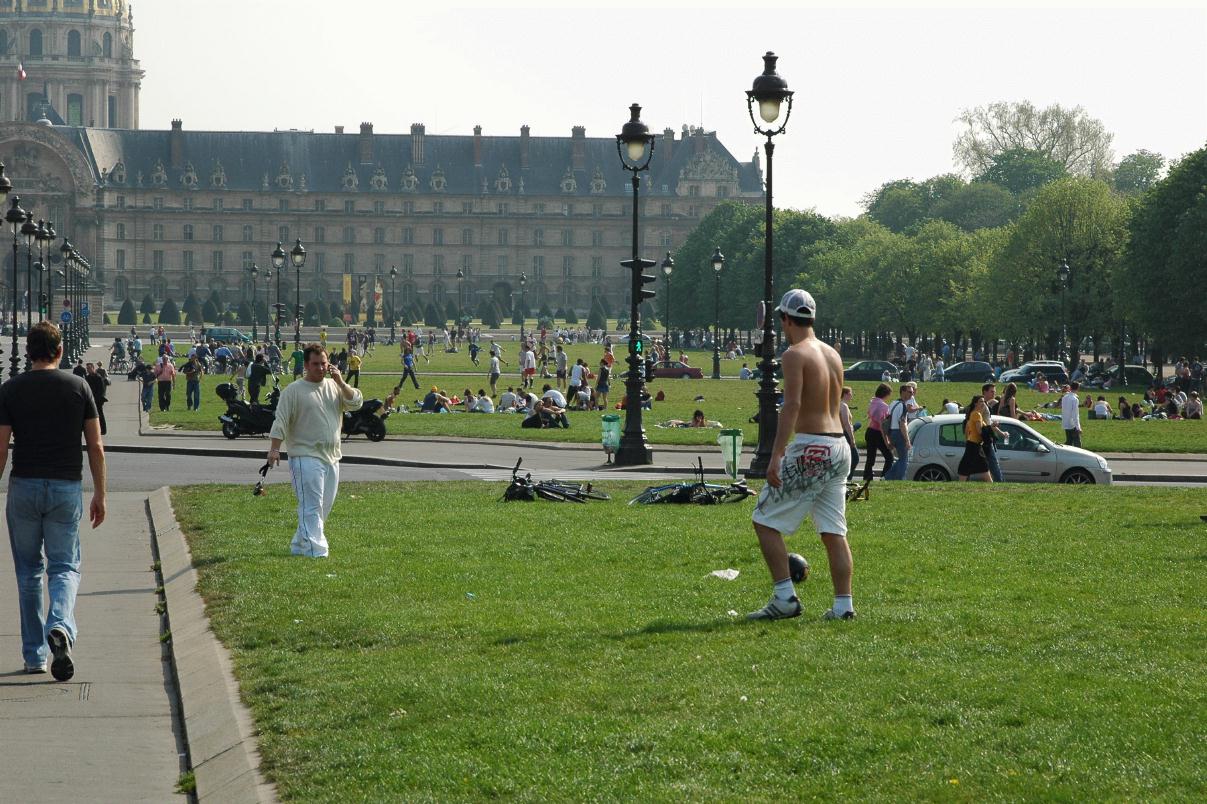 | |
|
Not visable from this shot is the roadway on the left that travels
down the middle of the esplanade. That roadway is a very busy one.
Consequently, despite the pastoral look of these grassy areas, those areas
were quite noisy with the sounds of traffic.
Dispite the traffic, the grassy areas were full of people that day because of the clear skies and hot tempertures. Some people toyed with socker balls while most others lounged on the grass. In this regard the French are much like people everywhere. Nice weather draws nearly everyone into the great outdoors. Where the French excell, however, is by the beautiful trappings with which they surround those who venture out. Card 25, City Walk: Paris • (2007) Esplanade Des Invalides, Paris, France, E.U. • Photo posted Thursday, May 17, 2007 • © 2007 Bryan Costales 
 #BP20070517.jpg Add a comment or report a mistake
|
|
|
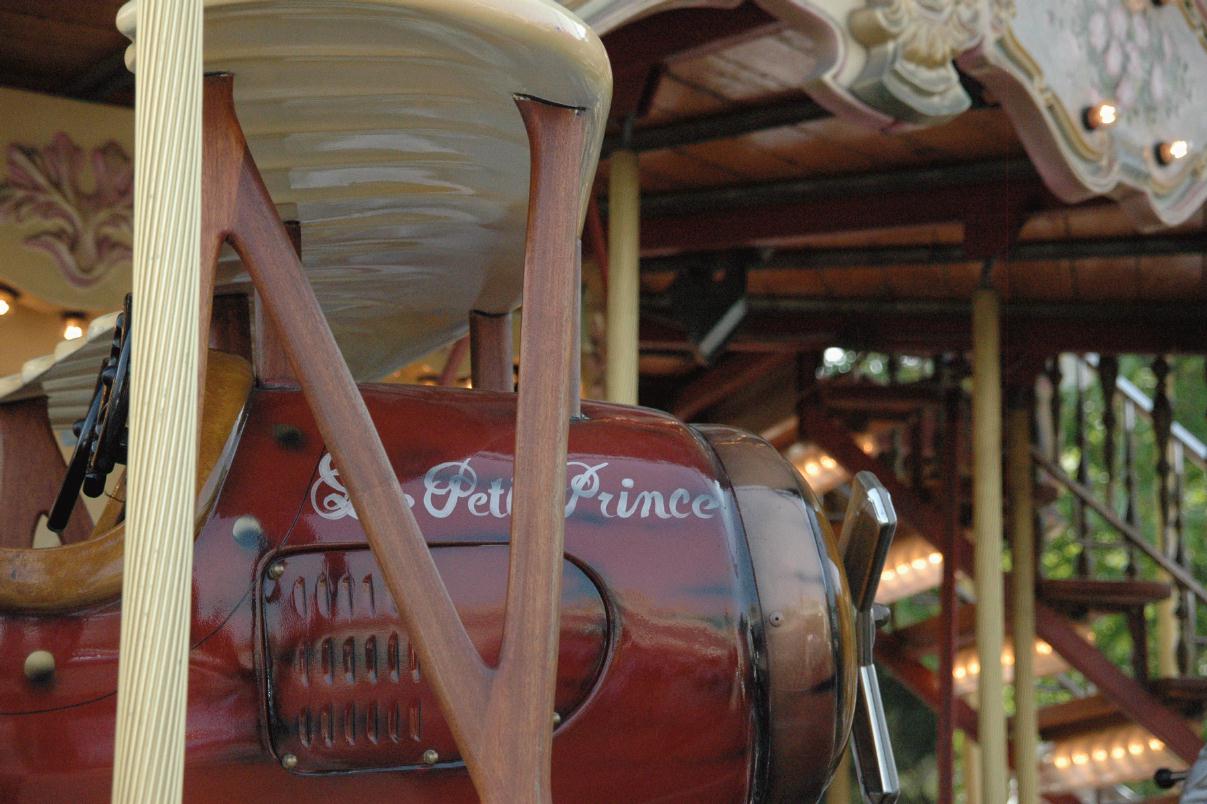 | |
|
This carrousel airplane was made to honor Antoine de Saint-Exupéry and
his famous book The Litte Prince (Le Petit Prince). I must admit that I
did not notice the whimsical detail of the feathered wings until seeing
the photo at home. At the time I just wanted to record another instance
of how the French love to honor their well-known artists.
For example there is a street named Rue de Victor Hugo in almost every village we visited. (2007) Carrousel De Paris, Paris, France, E.U. • Photo posted May 18, 2007 • © 2007 Terry Costales 
 #BP20070518.jpg Add a comment or report a mistake
|
|
|
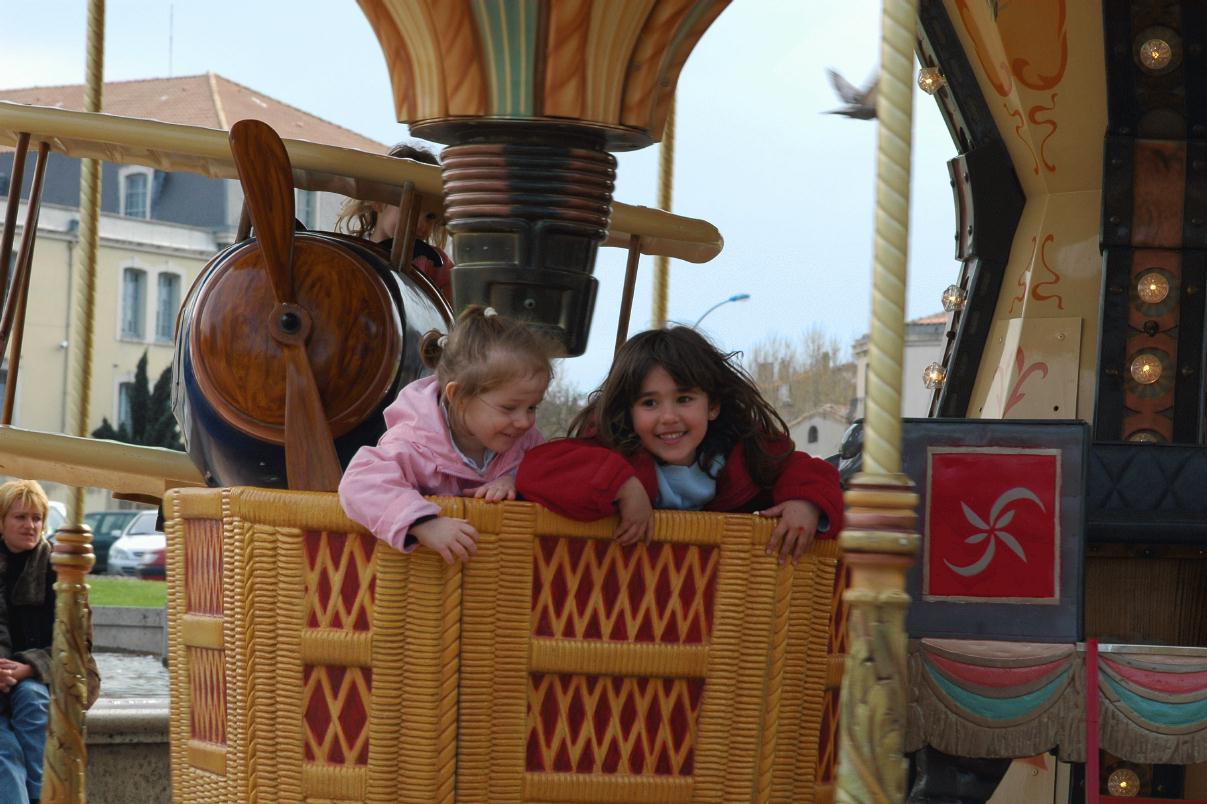 | |
|
French writer Jules Verne
Of course the mother watching would never wish such a calamity on her children. For her, it is just a gentle spring day in the park. A carrousel slowly turns to the tinkle of piped music. Birds fly overhead. A fine and relaxed day in Carcassonne. And yet... (2007) Carrousel 1900, Carcassonne, France, E.U. • Photo posted May 19, 2007 • © 2007 Bryan Costales 
 #BP20070519.jpg Add a comment or report a mistake
|
|
|
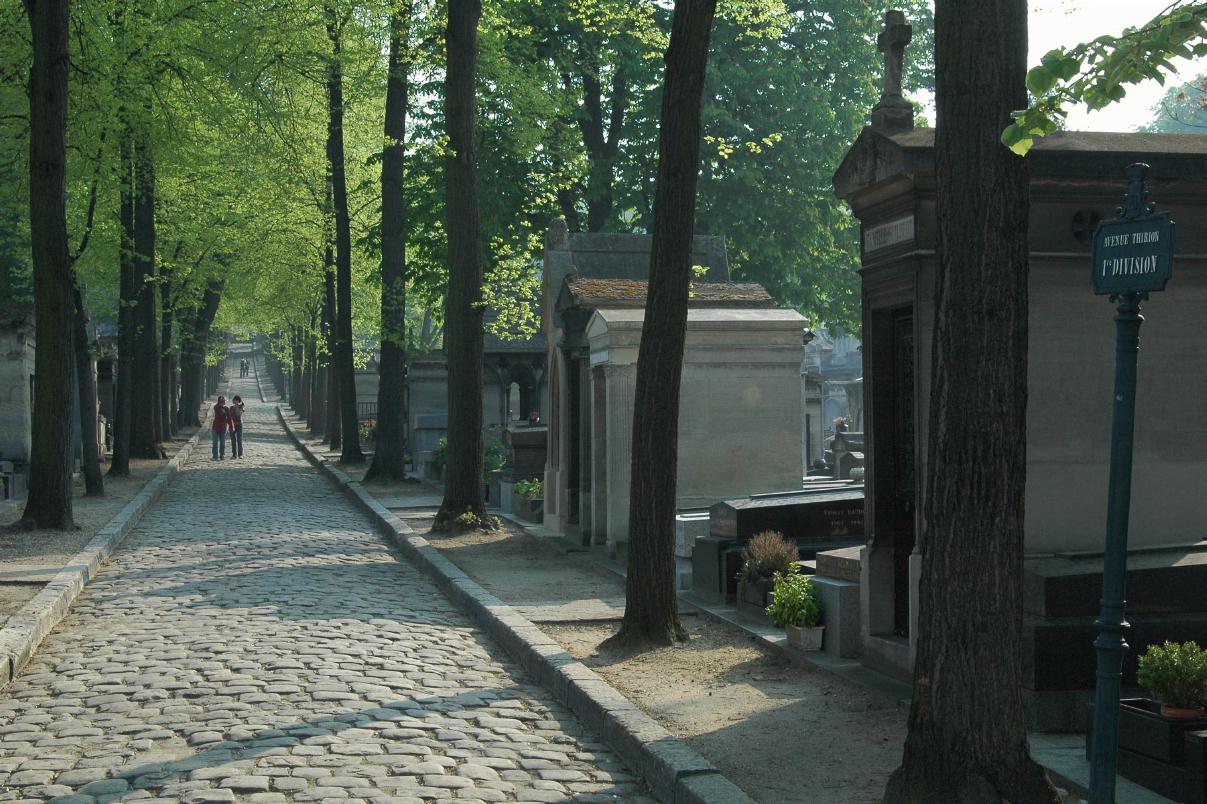 | |
|
It is difficult to describe the sheer immensity of this cemetery,
but perhaps a few facts will help. Pere Lachaise cemetery
currently houses about 300,000
dead compared to Iceland's 301,000 living (the dead are more
compact). The cemetery is 188 acres (48 hectares) or about the size
of roughly 100 American football fields. The interesting thing about
this photograph of a
long row of graves is that this path only runs a short way into the
cemetery.
By another measure, we spent three hours touring and photographing the cemetery and calculate that we only viewed perhaps one tenth of the graves. If you go, plan at least a week to see it all. (2007) Pere Lachaise cemetery, Paris, France, E.U. • Photo posted May 20, 2007 • © 2007 Bryan Costales 
 #BP20070520.jpg Add a comment or report a mistake
|
|
|
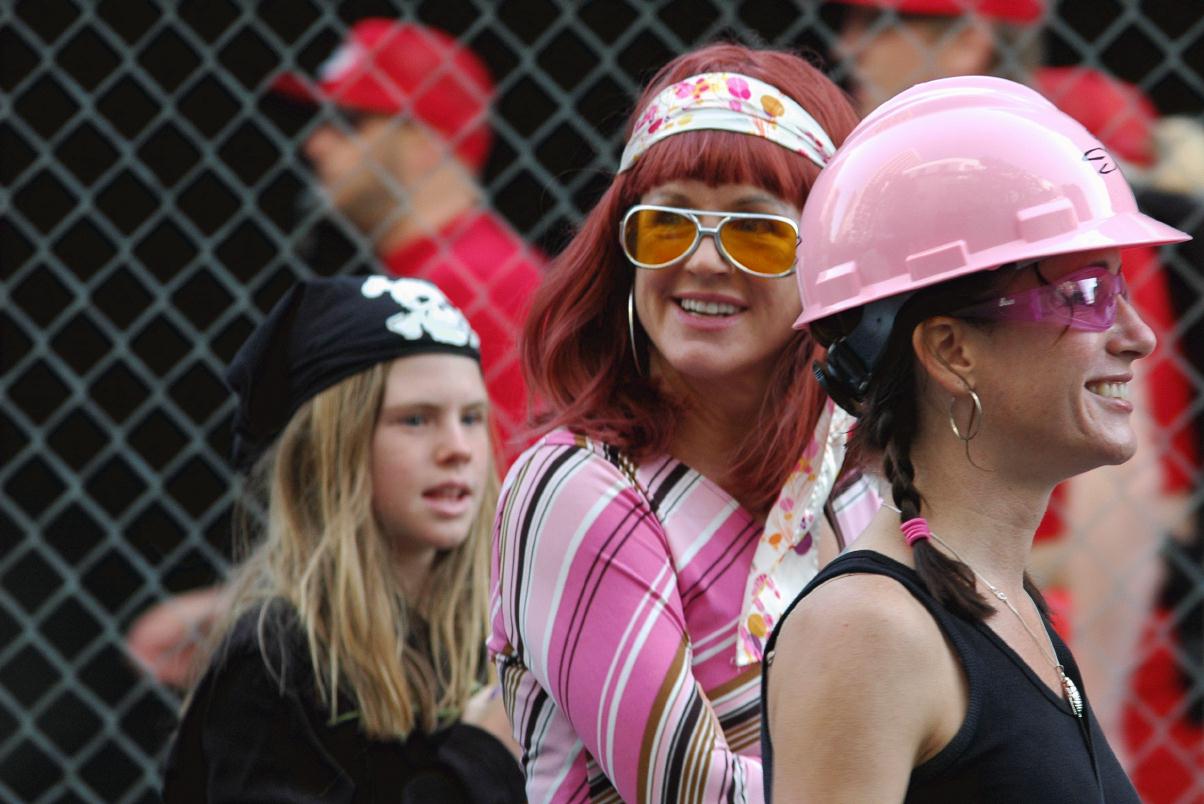 | |
|
All generations attend the race
The Bay to Breakers race has been labeled over the years with
epithets ranging from crazy drunks
Despite the evolution of
nude runners, this race
has matured into a fun event for all ages. Even
babys in strollers
(2007) Bay To Breakers Race, San Francisco • Photo posted May, 21 2007 • © 2007 Bryan Costales 
 #BP20070521.jpg Add a comment or report a mistake
|
|
|
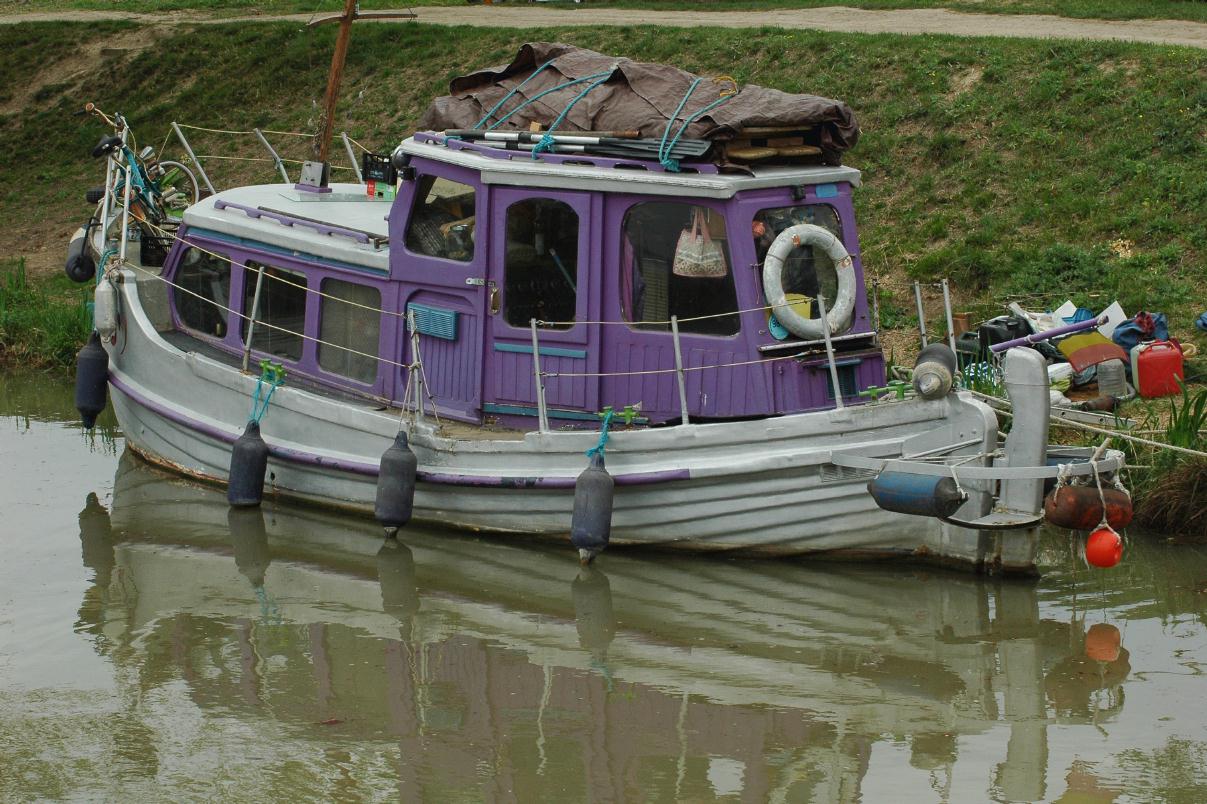 | |
|
One might get the impression from the pictures we take, that most
of the boats on French canals are for rent. In actuality, many are
owned by local folk who
live aboard
Organizations, such as the Barge Association
(2007) Canal Du Midi, France, E.U. • Photo posted May 23, 2007 • © 2007 Bryan Costales 
 #BP20070523.jpg Add a comment or report a mistake
|
|
|
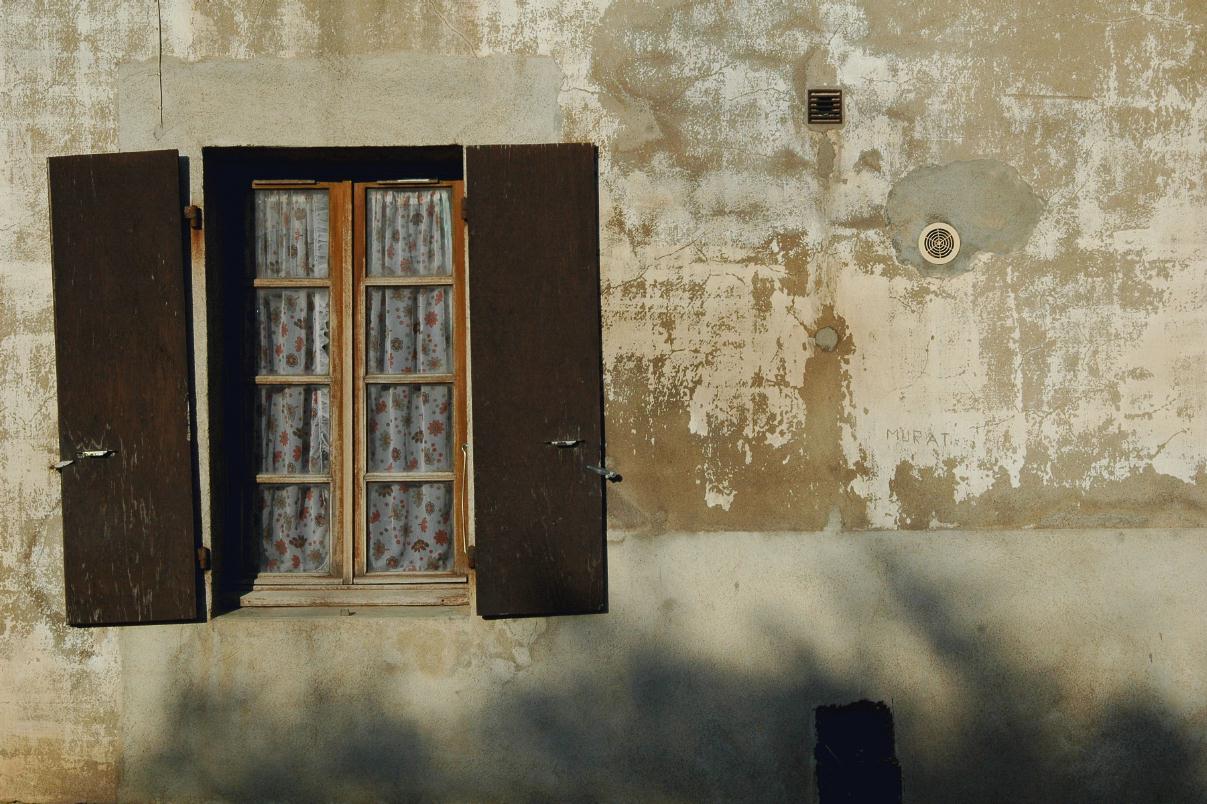 | |
|
All throughout Europe, houses have shutters. Shutters serve
two purposes, first to protect windows from storm damage, and second
to mask sunlight so that a room may be made dark during the day.
Perhaps because of this latter property, it seems most often that
the only interior window coverings are shears.
In this early morning shot, the sun has just cleared the tree tops and is shining brightly into this home. Perhaps inside a man sees the sunlight streaming in and decides today will be a fine day indeed. But, because this is France, the man probably thinks that thought in French. Dr. William Carter, Friday 25 May 2007
Shutters also serve to insulate (energy prices are high here)... and,
they aid in keeping the Caliphates out
Aujourd'hui sera un jour beau en effet (2007) Homps, France, E.U. • Photo posted Thursday, May 24, 2007 • © 2007 Bryan Costales 
 #BP20070524.jpg Add a comment or report a mistake
|
|
|
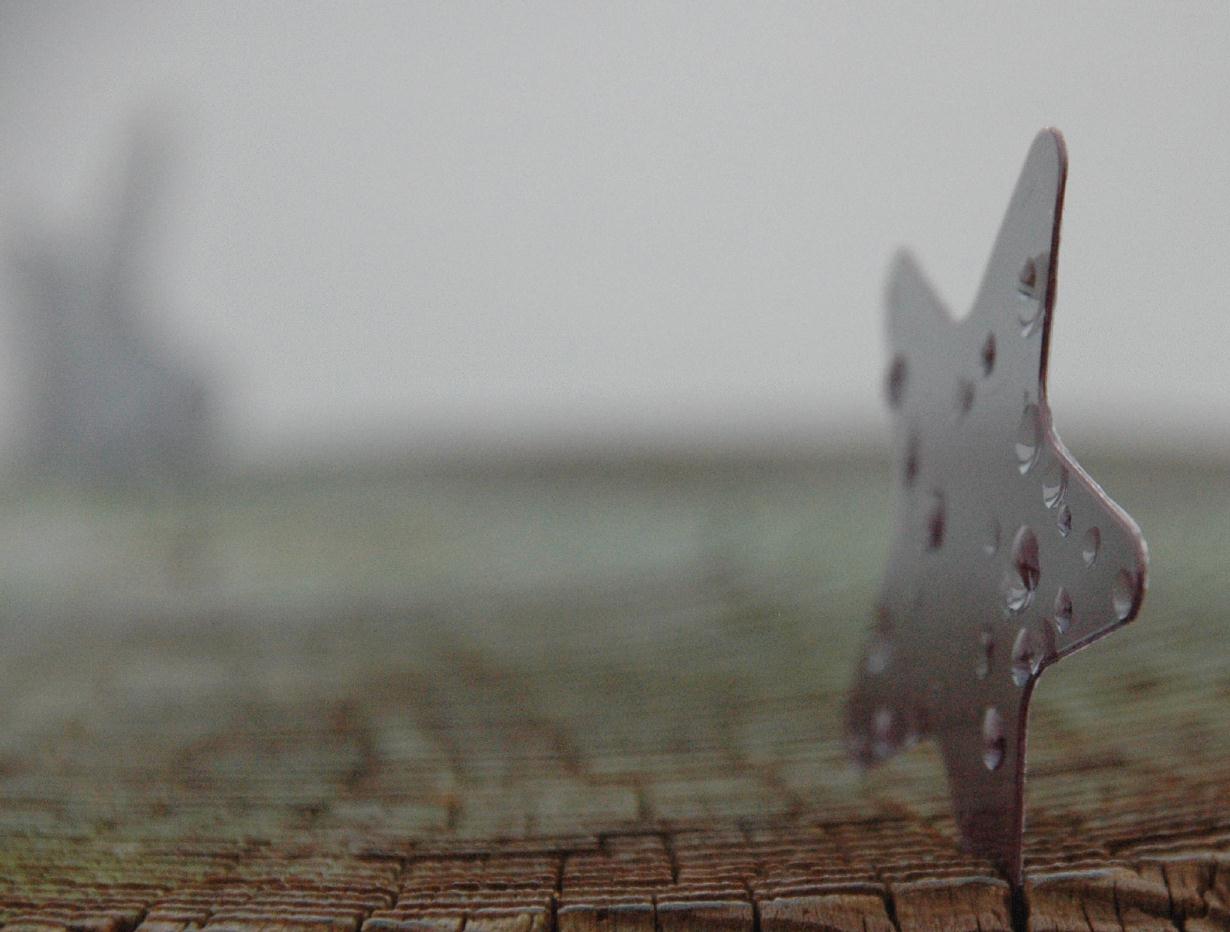 | |
|
While on a walk back from the Aquarium on a rainy afternoon, we
stumbled across these plastic stars stuck in the top of a stump.
We puzzled over them for several minutes but could not guess what
they might be. Further down the trail we found a pair of
abandoned sun glasses
Such revelations are sadly rare. More often, one will find something strange, puzzle
over it, and never solve what it might have been. Such found object, re-abandoned,
are quickly forgotten. But sometimes, found objects are collected, and sometimes
found objects are turned into art
The Tate Museum
Here's hoping that all you have lost may be someday found. (2007) Monterey, California • Photo posted Friday, May 25, 2007 • © 2007 Bryan Costales 
 #BP20070525.jpg Add a comment or report a mistake
|
|
|
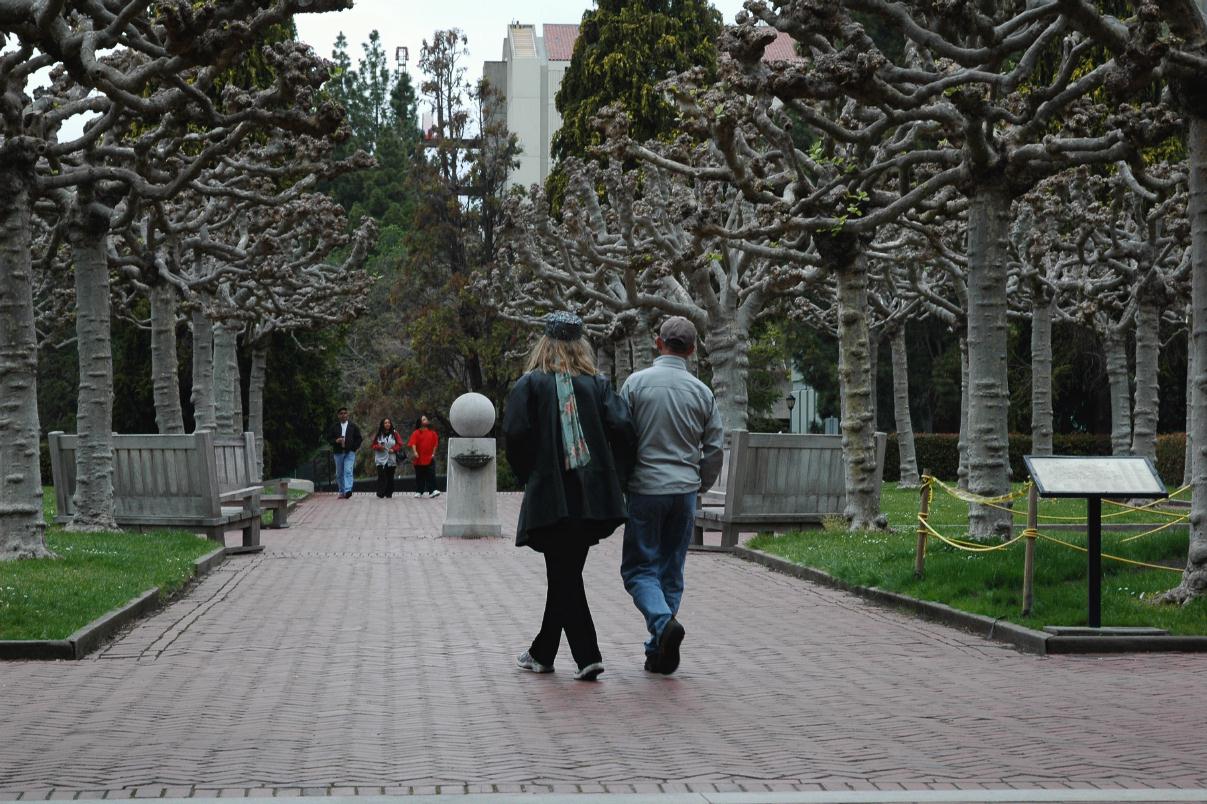 | |
|
The esplanade at the foot of Sather Tower
Four floors store fossils, and a fifth stores patent copies from the Library.
As a student, I worked in
Doe Library's
Perhaps it was these jovial juxtapositions of bones that led later
to such hair-brained sites as
creationism.org (2007) U.C. Berkeley, California • Photo posted Saturday May 26, 2007 • © 2007 Bryan Costales 
 #BP20070526.jpg Add a comment or report a mistake
|
|
|
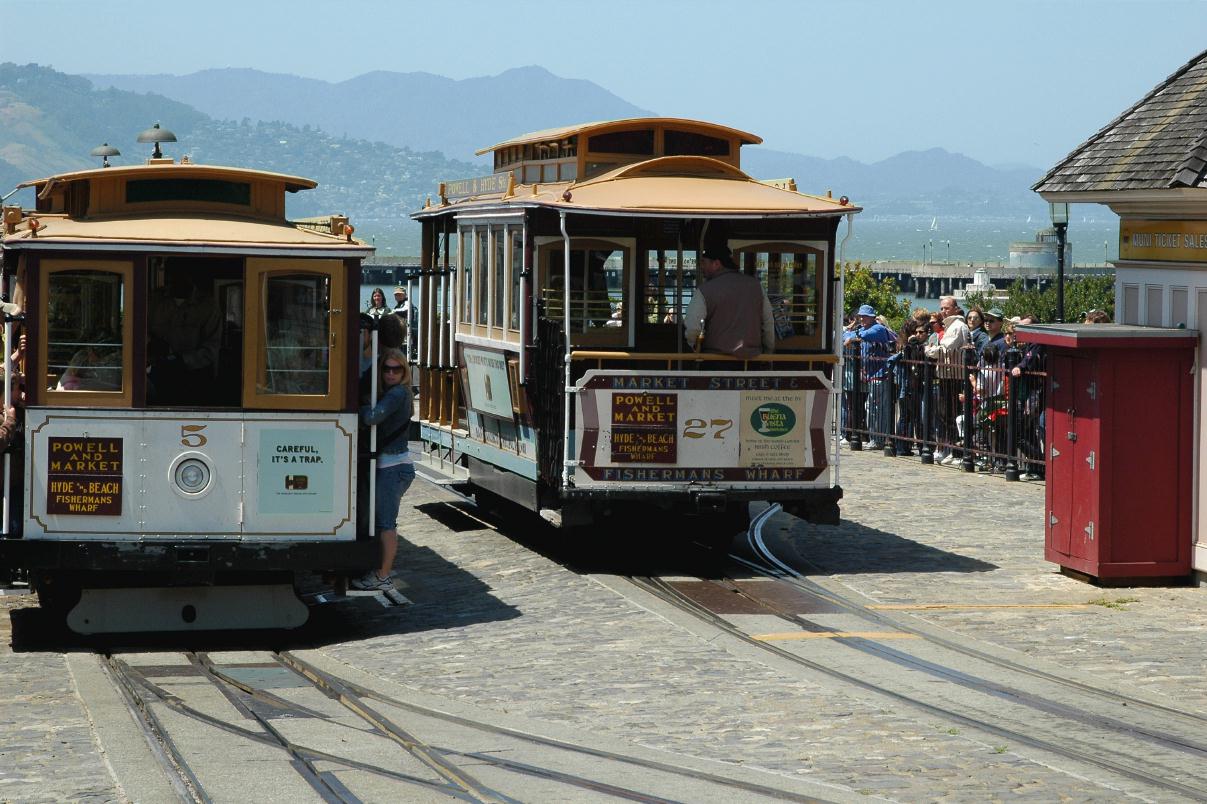 | |
|
Here we show cars number 5 and 27 of the Powel and Market to Hyde and Beach
line. These are single ended cars that have to be rotated at each end.
To learn more than you thought you might ever want to know about
San Francisco's cable cars, click on
the
Cable Car Museum
Just one short block up the hill from these cable cars is
the proported origin of Irish Coffee at the
Buena Vista Cafe Now that you know how to make an Irish Coffee, why not kick back and make one tonight. Have a sip and toast the Cable Cars. (2007) City Walks: 14, San Francisco, California • Photo posted Sunday May 27, 2007 • © 2007 Bryan Costales 
 #BP20070527.jpg Add a comment or report a mistake
|
|
|
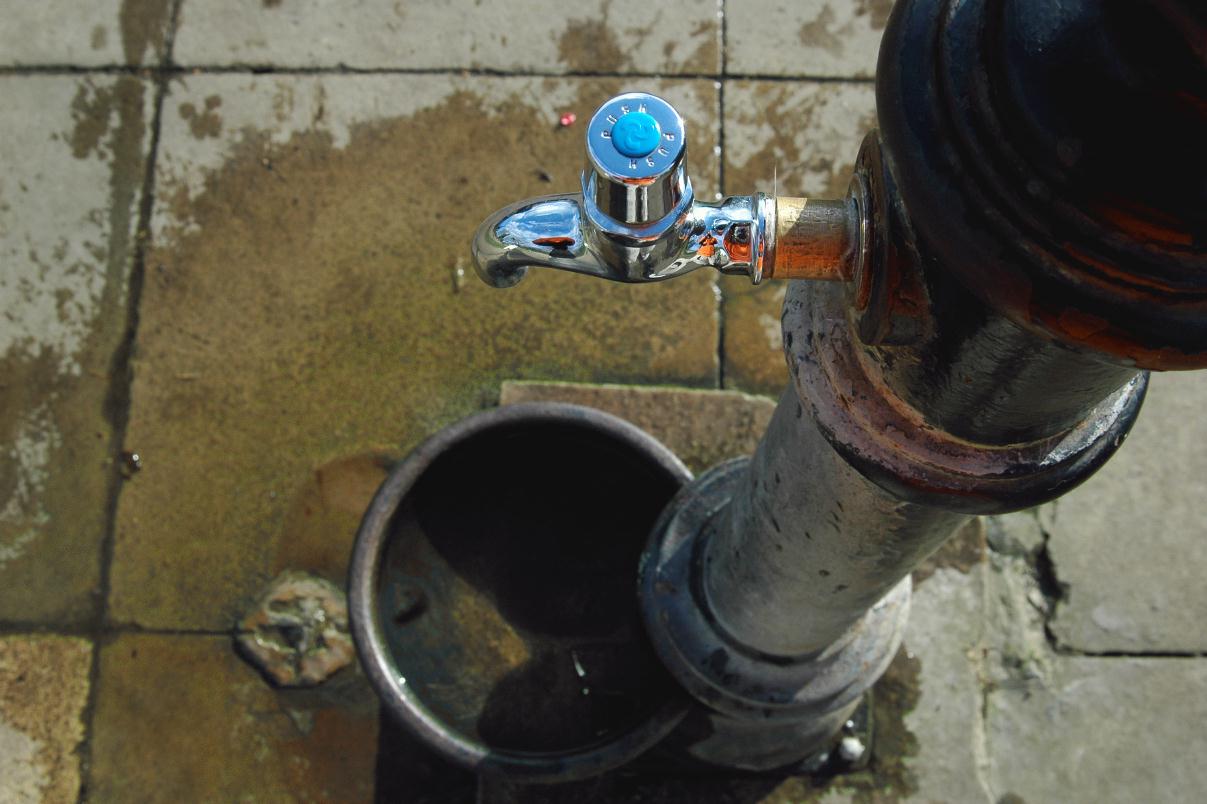 | |
|
From this picture it is clear that the English know how to
give water to a dog. As any sane person knows, you just fill
a bowl with cool tap water and man's-best-friend will lap it down
joyfully.
We here in the States have grown accustomed to
drinking water in flavors. Not only that, but we now look to
water for vitamins as well.
But wait, that ain't all. Now too comes
flavored water for dogs
What happened to the happy dog that would slaver over a simple bowl of water from the tap? Dogs have not changed. Dogs now are pretty much like the dogs we knew ten years ago. What changed, of course, is people like you and me. We changed. We are no longer content to buy bread in a bakery (boulangerie) and cheese in a cheese store (fromagerie). Instead we look for everything pre-created to be as convenient as possible in a supermarket (supermarché). Is it any wonder then that the convenience and desire for creature comforts would rub off onto our dogs? (2007) Hyde Park, London, England • Photo posted Monday, May 28, 2007 • © 2007 Bryan Costales 
 #BP20070528.jpg Add a comment or report a mistake
|
|
|
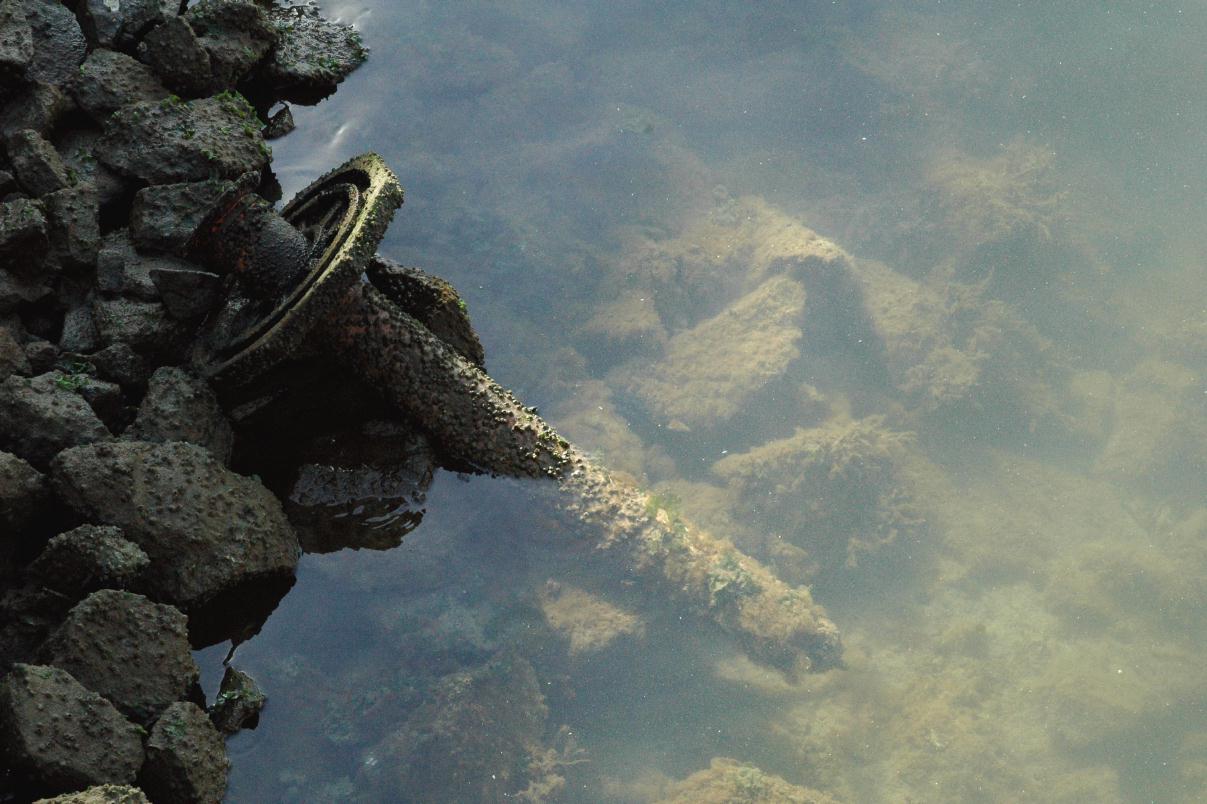 | |
|
All that is left of a car long ago dumped in the bay is
its axle. Normally it would remain invisible, but this day's
minus tide exposed the rusty axle for a while.
On the road to zero footprint consumerism the automobile lags far behind. Tires are being recycled into playground paths. Tennis shoes are being recycled into basketball court floors. Aluminum cans are being recycled into aluminum cans. But automobiles are still junked, crushed, and only partly recycled. And along the road, each car will consume almost a thousand gallons of gas per year.
The Tesla
By far the best way to travel is by rail. In Europe large cities have extensive underground rail. In London and Paris, the underground rail stations are only a few blocks from anywhere in town. In San Francisco, the cost of putting rail underground has grown so expensive that only one new mile is currently planned. The longer we wait to put rail underground, the more expensive the task grows. Because there is no circumstance that will make the task cheaper in the future, all cities should bite the bullet and put all rail underground now. Why in the world should we wait for the cost to double before acting? (2007) San Francisco, California • Photo posted Tuesday May 29, 2007 • © 2007 Bryan Costales 
 #BP20070529.jpg Add a comment or report a mistake
|
|
|
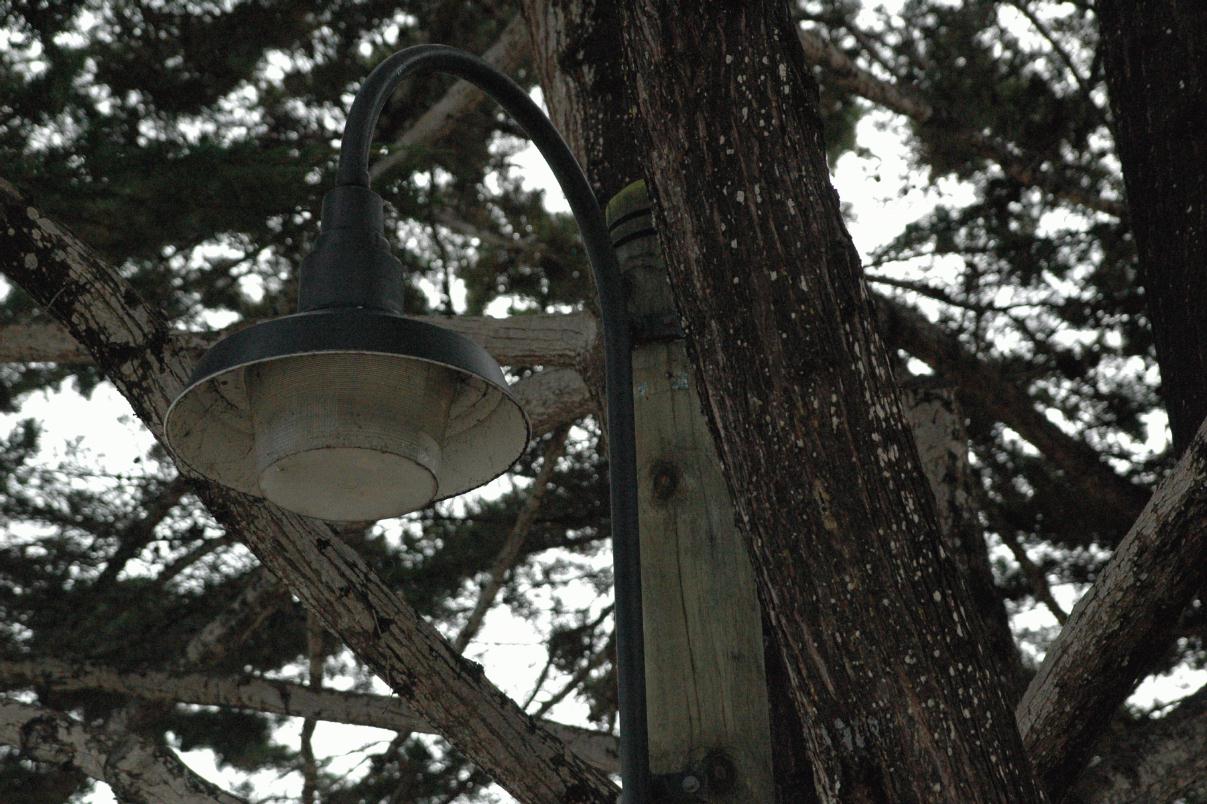 | |
|
One way to illuminate a woody path is to attach a lamp
to a wooden post and nestle it into a tree. Far from fooling
anyone, however, this attempt at concealment is weak at best, and ugly
to boot.
Along other paths the lamp itself adds to the impression of beauty. A good street light should be, after all, not just a source of light but a sculpture that illuminates. Instead, most streetlights are not only pure utility but suck huge amounts of electricity. Stick a 500 watt lamp in a street light and plunk it on an aluminum pole and plant that poll on a street corner. Count up the street corners in a small town and you quickly consume hundreds of ugly kilowatts just illuminating empty streets all night. Could we save electrify by detecting movement and only lighting up when a car or person was present? Or what if pedestrians had to carry their own lights, much like cars are required to have headlights for nighttime travel? Or what if LED bulbs could be used in streetlights? Many questions today, and no bright light of answers. (2007) Monterey, California • Photo posted Wednesday May 30, 2007 • © 2007 Bryan Costales 
 #BP20070530.jpg Add a comment or report a mistake
|
|
|
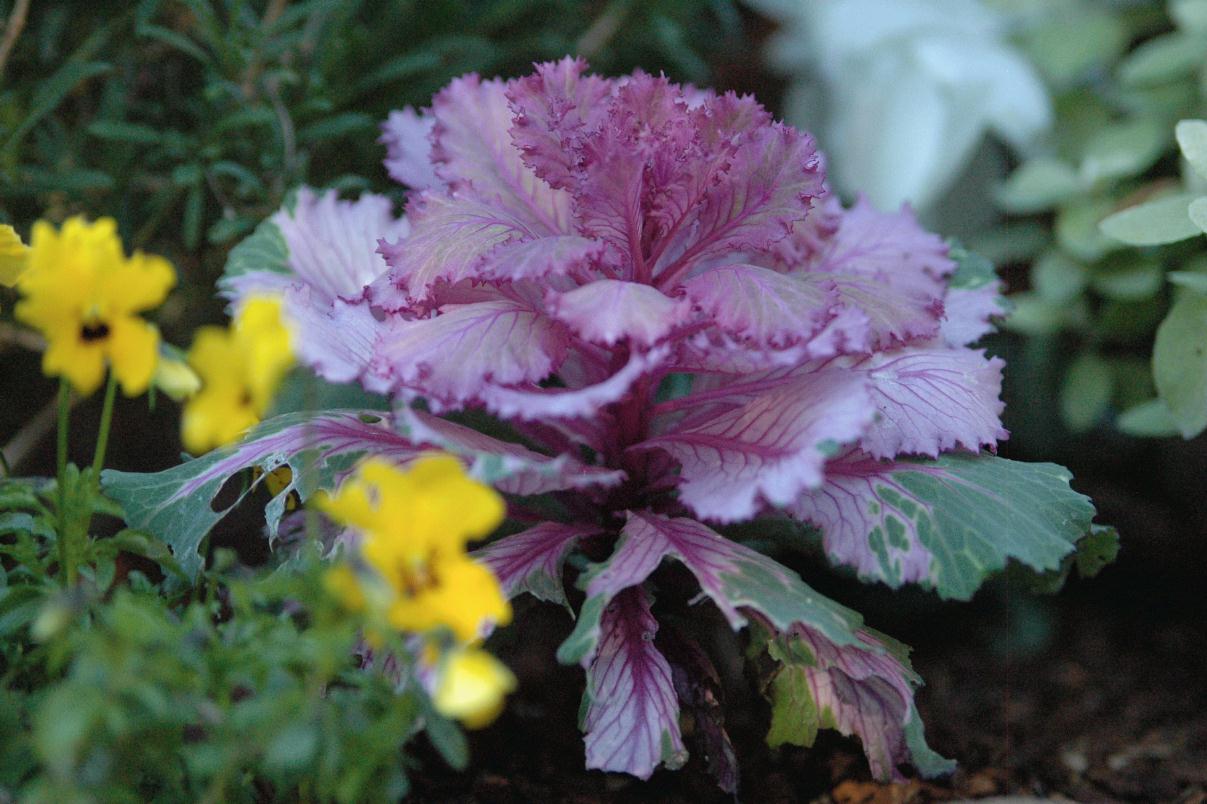 | |
|
Imagine a children's tale about a cute little
purple-cabbage that
went out for a night on the town. It was a blue moon that night,
just as it is tonight when we tell this tale. The cute little
purple-cabbage froliced through the garden, talking and laughing with
all the other fine vegetables there. One adventure followed
by another (such as when she was attacked by
French snails in
San Francisco). Later, just before dawn,
the cute little purple-cabbage fell sound asleep.
At dinner that night, the child's mother announced, "Tonight we will become vegetarians." The mother describes to the child all the awful ways that animals are slaughtered to produce meat for the table. So convincing is the mother that the child weeps and promises never to eat meat again. The child, anxious for dinner is surprised by a salad set on the table. The top of the salad is littered with torn pieces of purple cabbage. The child wails, "You slaughtered the cute little cabbage." (2007) Trebes, France, E.U. • Photo posted Thursday, May 31, 2007 • © 2007 Bryan Costales 
 #BP20070531.jpg Add a comment or report a mistake
|
|
 |
| home • contact • topic guide • top 25 • photos • video • writing • blogs • upload • terms • privacy |